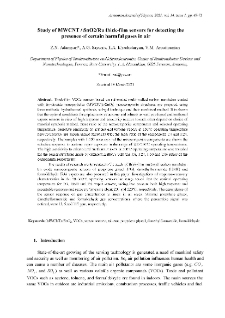Object
Title: Study of MWCNT / SnO2/Ru thick-film sensors for detecting thepresence of certain harmful gases in air
Publication Details:
Journal or Publication Title:
Armenian Journal of Physics=Ֆիզիկայի հայկական հանդես
Date of publication:
Volume:
Number:
ISSN:
Official URL:
Corporate Creators:
Yerevan State University, Department of Physics of Semiconductors and Microelectronics
Coverage:
Abstract:
Thick-film VOCs sensors based on ruthenated multi-walled carbon nanotubes coated with tin-dioxide nanoparticles (MWCNTs/SnO2) nanocomposite structures are prepared using three methods: hydrothermal synthesis, sol–gel technique and their combined method. It is shown that the optimal conditions for applications as acetone and toluene as well as ethanol and methanol vapors sensors in view of high response and selectivity relative to each other depend on choice of material synthesis method, mass ratio of the nanocomposite components and selected operating temperature. Selective sensitivity to acetone and toluene vapors at 150oC operating temperature MWCNTs/SnO2 are shown sensor structures with the mass ratio of the components 1:4 and 1:24, respectively. The samples with 1:200 mass ratio of the nanocomposite components are shown the selective response to acetone vapor exposure in the range of 200-250oC operating temperatures. The high sensitivity to ethanol and methanol vapors at 200oC operating temperature was revealed for the sensor structures made by different methods with the 1:8, 1:24, 1:50 and 1:66 ratios of the components, respectively. The results of research works related to the study of thick-film multiwall carbon nanotube– tin oxide nanocomposite sensors of propylene glycol (PG), dimethylformamide (DMF) and formaldehyde (FA) vapors are also presented in this paper. Investigations of response–recovery characteristics in the 50–300oC operating temperature range reveal that the optimal operating temperature for PG, DMF and FA vapor sensors, taking into account both high response and acceptable response and recovery times are about 200 and 220oC, respectively. The dependence of the sensor response on gas concentration is linear in all cases. Minimal propylene glycol, dimethylformamide and formaldehyde gas concentrations, where the perceptible signal was noticed, were 13, 5 and 115 ppm, respectively.
Format:
Identifier:
click here to follow the link ; oai:arar.sci.am:269263
Location of original object:
ՀՀ ԳԱԱ Հիմնարար գիտական գրադարան
Object collections:
Last modified:
Dec 13, 2023
In our library since:
Apr 17, 2021
Number of object content hits:
165
All available object's versions:
https://arar.sci.am/publication/293278
Show description in RDF format:
Show description in OAI-PMH format:
-
Armenian Journal of Physics=Ֆիզիկայի հայկական հանդես
-
Armenian Journal of Physics, 2008
-
Armenian Journal of Physics, 2009
-
Armenian Journal of Physics, 2010
-
Armenian Journal of Physics, 2011
-
Armenian Journal of Physics, 2012
-
Armenian Journal of Physics, 2013
-
Armenian Journal of Physics, 2014
-
Armenian Journal of Physics, 2015
-
Armenian Journal of Physics, 2016
-
Armenian Journal of Physics, 2017
-
Armenian Journal of Physics, 2018
-
Armenian Journal of Physics, 2019
-
Armenian Journal of Physics, 2020
-
Armenian Journal of Physics, 2021
-
Armenian Journal of Physics, 2021, vol. 14
-
Armenian Journal of Physics, 2021, vol. 14, № 1
- Fermionic Condensate on Finite Radius Cones
- Cobalt Doped SnO2 Thin Film for Detection of Vapor Phase Hydrogen Peroxide
- Bilateral Measurements in Electrical Circuits with Gas-discharge Devices
- Bose-Einstein Condensation and Supersolids
- Theoretical Study of Transition Metal Dichalcogenides Compound TiS2 and Their Intercalated Compound CrTiS2 Using Density Functional Theory
- Study of MWCNT / SnO2/Ru thick-film sensors for detecting thepresence of certain harmful gases in air
- Single Wall Carbon Nanotube Gas Sensors
-
Armenian Journal of Physics, 2021, vol. 14, № 2
-
Armenian Journal of Physics, 2021, vol. 14, № 3
-
Armenian Journal of Physics, 2021, vol. 14, № 4
-
Armenian Journal of Physics, 2021, vol. 14, № 1
-
Armenian Journal of Physics, 2021, vol. 14
-
Armenian Journal of Physics, 2022
-
Armenian Journal of Physics, 2023
-
Armenian Journal of Physics, 2024
-
Armenian Journal of Physics, 2025
-
Armenian Journal of Physics, 2008
| Edition name | Date |
|---|---|
| Adamyan, Z. N., Study of MWCNT / SnO2/Ru thick-film sensors for detecting thepresence of certain harmful gases in air | Dec 13, 2023 |





